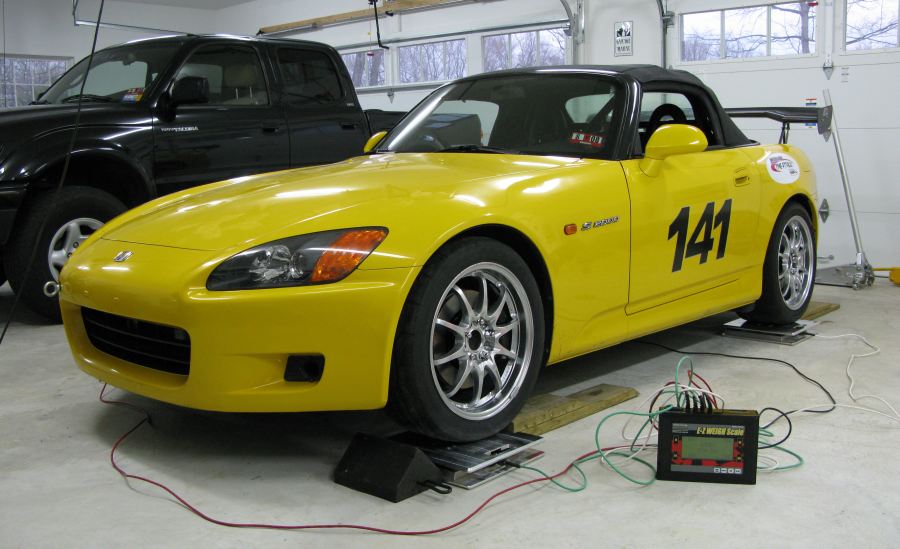Recommended Reading
You need a nice, flat and level surface for the scales.
I highly recommend using a laser level to confirm the 4 scales are level to one
another. Even 1/8 inch difference will make a difference, especially if you have
stiff springs on your coil overs. I used a laser level to project a horizontal
line above each scale and placed a ruler on the top
of the scale to take a reading. All 4 scales must be within 1/8 of an inch. I
used linoleum tiles to shim two of my scales to get them all level.
Check your tire pressure and bump it up to the hot pressure
you run on the track. I use 2x6 wood planks as ramps to drive the car onto
the front ramps then jack up the rear and lower it onto the rear scales. It's
difficult to position all 4 scales so you can just drive up on all of them at
the same time.
Before putting your car on the scales you need to power up
the scales and zero them with no weight on them. Also double check that the
scales are connected properly--you can really screw up your suspension settings
if you have any of the scales connected improperly (i.e. front left and
right swapped).
If you don't have adjustable end links on your
anti-roll bars then leave them connected. If you do have adjustable end
links then disconnect them for the corner balance. Once the corner
balance is complete put someone in the driver seat and reconnect the
anti-roll bar with the end-link adjusted so it's easy to insert the
end-link into the anti-roll bar's hole.
Once you get the car up on the scales you'll
need to roll the car back and forth a few inches several times, being careful
not to push it off the scales, to unload the suspension (as the car is
lowered onto the scales the tires will need to spread out to unbind the
suspension). You will have to repeat this every time you lower the car onto
the scales.
Note your ride heights and
suspension changes to track your progress. When you adjust your coil overs
to get the desired corner weights your ride height will change. Always
document your current ride heights and your coil over changes each time
you weigh and adjust. It's better to make many small changes than to try
to balance your car in one big step. You can also estimate your car's
center of gravity (CG) height by using this page:
CG Height Calculator
Cross Weight = Right Front + Left Rear
Cross Weight % =
(Right Front + Left Rear) / (Left Front + Right Rear)
When balanced the Cross Weight % will be 50%
Bite and Wedge Delta are
important for oval racers, especially on dirt ovals. Since oval
racers only turn left we can balance the car for better grip in left
turns. Bite tells us how much we
are favoring the left rear tire for better acceleration out of left
turns. Bite = Left Rear - Right Rear and a positive value means the
Left Rear tire is carrying more weight so it will get more traction and
bite, a negative value means the Right Rear is favored.
Wedge is a term used in the
oval racing world and is simply another word for Cross Weight. Oval
racers discovered they could insert an actual wedge into the left rear
springs to put more weight on the left rear (and right front) tires and
it would help the car turn left and accelerate better. Today's oval
racers add "wedge" by adjusting the right rear spring perch--they
retract the right rear tire which puts more weight on the Left Rear and
Right Front tires.
When a NASCAR crewchief says he's "adding wedge",
what he means is he's adding weight to the left rear and right front
tires. To keep things clear I call this added weight Wedge Delta
which is simply the difference between the two diagonal tire weights. Wedge Delta can also be thought of
as Left Rear Bite + Right Front Bite.
Wedge
Delta is equal to (Right
Front + Left Rear) - (Left Front + Right Rear) and tells us how much
extra weight is on the left rear and right front tires which gives them
more traction or bite in left turns. For ovals we want a
positive Bite and positive Wedge Delta. When Wedge is balanced at
50% then Wedge Delta will be 0. Of course you can add too
much Wedge Delta and make the handling worse. Keeping track of Bite and
Wedge Delta and what values work best for certain tracks and conditions
can help us get our setup right with less testing. Road racers are
typically not concerned with bite and wedge delta because they usually
want balanced turning in both directions.
Road racers can take a page out of the oval racing book and
intentionally favor a turn direction. If most of the important turns on your
track are left turns then having more weight on the Right Front and Left Rear
will help with those turns. To favor right turns, put more weight on the
Left Front and Right Rear but you'll have to test to find out what works best.

On the Scales